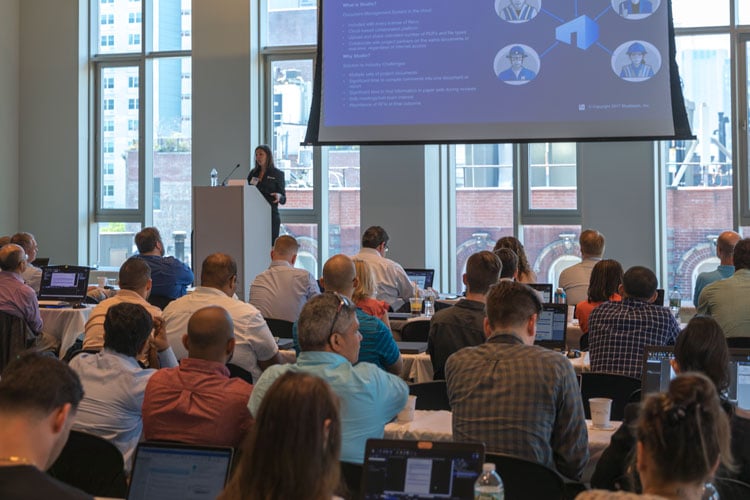Benton Johnson is an Associate Director at Skidmore, Owings & Merrill LLP (SOM), where he leads efforts on the Timber Tower Research Project, a multiyear effort to test the limits of mass timber construction. With a recent spate of timber high-rises in the past few years and with a slew of new builds as cross-laminated timber comes into its own in North America, it’s clear there’s a movement toward a new, sustainable type of construction that makes the most of this very old-fashioned material. StrXur interviewed Johnson to talk about the present and the future of timber construction.
Built Blog: What was it that jump-started your interest in timber as a building material?
Johnson: People had been talking about mid-rise or high-rise timber construction and there was one particular project, the Kirkenes Cultural Center, that caught my attention. The project was a conceptual design that didn’t go forward, but it was proposed to be 16 stories tall. I thought it was really cool that people were exploring using timber on a large scale. But more specifically, the main thing that got me kicked off professionally was that our urban planning partner put out a challenge that everybody needed to be doing whatever they can regarding sustainability. As a structural engineer, that’s the biggest tool in your tool pouch—timber structures.
Built Blog: Tell me a bit about the Timber Tower Research Project. It’s now 5 years old. What kind of research have you done?
Johnson: That’s right. We’ve now published four different research reports on a timber construction, offering something like over 400 pages of content. We’re really getting down into the weeds. The most recent thing that we’ve done is complete a floor testing program at Oregon State University.
If I could summarize the findings, it’s pretty simple. Mass timber has a lot of great benefits because it’s lightweight, but because it’s lightweight, it has other challenges related to floor vibrations and acoustics. The way that people have been solving that is by pouring a concrete topping slab over their timber. What we’re doing is using that concrete topping slab that you already need for acoustics and using it to enhance the spanning capabilities of the floor system. That way we can have fewer columns, fewer beams, fewer walls, and make the floorplans more open and more usable. The testing program was really based around that and proving out some of those concepts. We’re trying to span further using materials that are needed for acoustics. The goal now is to get that building technology into real buildings and to get projects built that use it, but we have to be sequential in how we do it.
There’s different levels, if you will: if you wanted to go into high-rise buildings, you have to have a much higher fire rating. We haven’t had a chance to do the fire testing yet. So right now, because of the testing program that we’ve done at Oregon State, we can use it on smaller projects that don’t need a large tested fire rating. We want to continue the research and development so that we can use it in a high-rise application as well.
Built Blog: This sounds like a pretty big deal—developing a whole new realm of possibilities for timber structures. How does that fit in with the objective of increased sustainability?
Johnson: Timber itself is a renewable resource and when you have a sustainably managed forest it has a lot of sustainability benefits, not just reducing global warming potential through a smaller carbon footprint. It also has things like improving air and water quality. Sustainably managed forests actually improve soil quality. You can show that forests help biodiversity and other things like the vanishing of bees. Having more forested land instead of open land is a good thing for sustainability on a broad level. Research shows that when you have a strong timber industry, it’s a protective use of that land. When you have value that comes out of managed forests, people want to keep those forests around. The idea is that if you have timber as a valuable and viable commodity, it enhances the sustainably managed forests while also reducing the carbon footprint of your building. The two kind of feed off each other.
Built Blog: And otherwise these buildings would just be steel and concrete, right?
Johnson: Yes, typically they’re going to be steel and concrete when you’re looking at buildings that want to be commercial usage. Having bigger column bays, you have more of an open floorplan, or being a high-rise to get a fire rating, it’s going to have to be steel and concrete. Mass timber and cross-laminated timber are challenging those assumptions within the code and we’re expecting that in the future, code provisions will change to allow bigger and taller mass timber frames because they are more fire resistant than a traditional wood frame.
Built Blog: So your research is probably helping the code progress?
Johnson: Absolutely. And we want to be a part of that process. We have contacts within the code bodies that we have discussions with to make sure we’re addressing these things appropriately.
Built Blog: How is this informing the firm’s personality and are you talking about this yet with owners as something they can do on their current projects, or talking about it and saying, “Look, keep this in mind, three or five years down the road we’ll be able to do something new”?
Johnson: We’re talking about it now. When you look at the size of projects that our firm typically does, we do things that are very, very large, so there are a limited number of projects where we can propose timber to our clients. But anytime we have a project come through that’s a viable candidate for timber, we do propose it. Sometimes it’s selected. For example, we’re doing a library in Long Beach, California, that’s now under construction. We want to select the right materials for the job and then we put it to the owner with all the facts they need, and they’ll make a decision on their own. I don’t think it’s a hard sell in terms of people wanting to do it. The biggest concern is can they get approval to build, because when it’s time to go on a project, they want to go right now. The challenge is that cross-laminated timber is still somewhat new, so questions arise like can we get it to the site on time, can we get it fabricated in time, or maybe the city’s never seen cross-laminated timber before and we need to get an exemption in the code. It’s not a big sell for the owners because they see the value, the potential. It’s just a question of finding the right project that has a long enough fuse that they can wait to go through all the necessary steps internally and with the city.
Built Blog: How would you summarize your ethos of building with timber?
Johnson: One of the things that I always try to stress to people on these things is that a lot of times people think, “Ok, if we’re going to use timber it has to be an all timber building, or if we’re going to use steel, it has to be an all steel building.” And we’ve been exploring a lot of hybrid solutions where we’re not trying to push the limits too much on timber construction, but find a sort of a natural balance with other materials. That’s why we did the AISC Steel and Timber system report, which looks at a structural steel frame with a timber decking as infill. And the beauty there is that using a lightweight structural steel frame and lightweight infill timber decking, you still get a very sustainable solution where the structural steel is all recyclable. We can still hit a lot of our other goals for using timber—prefabricated, lightweight and everything else. One of the things I stress to people is that it doesn’t have to be all or nothing.
Built Blog: Tell me a bit about the library in Long Beach that SOM is building.
Johnson: Sure. It’s under construction now. It’s not cross-laminated timber, it’s all traditional glulam framing and blocked plywood decking. The project is quite awesome because it actually reuses an existing below-grade parking garage to support the new building. We removed existing landscaping and miscellaneous structures above the garage so that the weight of the new library could be supported by the old foundations. And if you want to talk about sustainability—it’s reduce, reuse and recycle in that order. Reducing your consumption is always better than using something and reusing it, and reuse is always better than recycling because there’s less energy input. This is a reuse of the existing foundations, which is great and very sustainable. The project also has high seismicity, so we used concrete filled steel tubes and a steel-braced frame seismic-load resisting system. In the renderings, you see the white columns that are steel with an ordinary paint system. This is a very hybridized system that’s trying to get the biggest bang for the buck of each material used.















